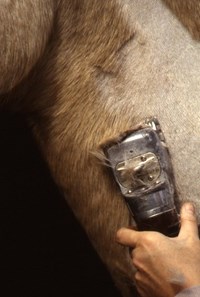Home > Horse Care > Q&A: Aversion to clippers
Q&A: Aversion to clippers
- September 10, 2025
- ⎯ Equus
Q: I have a 23-year-old mare who has never been clipped. But now she has Cushing’s disease, so this year her summer coat grew in too thick, and I worried about her when it was very hot. I decided that next year I should clip her after she has shed her winter coat. However, she has never liked the sound of small machines, such as an electric drill or the farrier’s grinding wheel. Someone suggested to me that I spend the winter getting my horse used to clippers before I actually have to use them.

However, when I turn the clippers on, the sound makes her very nervous. I tried leaving the clippers running in the corner of the barn and turning her loose in the barn aisle, leaving a pile of hay about 10 feet from the clippers. I had hoped the hay would entice her and she’d get used to the sound, but it didn’t.
Then I wondered, if the sound is really hurting her ears, would earplugs help? Or should I consider having her sedated while I clip her? I’m hoping someone with experience in this can offer advice.
A: It sounds like you’ve already taken some good steps to help your mare get used to clippers. I think the pile of hay is a good idea, although the hay may not be “high value” enough to really motivate your mare. I agree that earplugs might help; I’d recommend the foam type sold in tack shops for show horses. Sedating your mare when you clip might also be an option, but I’d encourage you to consult with your veterinarian about that.
To train your mare to accept clippers, I recommend positive reinforcement. This method has been proven to be quicker, most effective for learning and safest for both horse and trainer. Positive reinforcement is not bribing a horse to behave. Instead, it aims to teach him to associate the clippers with something good (treats or praise), to keep him calm and unafraid, and to “shape” the desired behavior in small, easy steps so it is easy for the horse to succeed. This approach works especially well for fearful horses or those who will fight to defend themselves if forced.
Start by turning on the clippers at a distance; wait until your horse stands still and is quiet for a moment, then tell her “Good,” give her a treat and turn off the clippers. Then repeat, coming closer one small step at a time. If she moves around, back the clippers away slightly, but don’t turn them off or reward her until she stands still. (If you turn off the clippers while she’s moving or acting out, you reinforce that behavior—she’ll learn that acting up turns off the clipper noise, which is the opposite of what you want her to learn.)
When she’ll tolerate the clippers running close to her, you need to get her used to the vibration she’ll feel as you clip. Place your hand on her neck or shoulder and bring the running clippers against the back of your hand, so she feels the vibration through your hand, then move your hand (with the clippers) gently over the places you’ll clip. Then repeat this step, placing the casing of the clippers (not the blades) against her skin.
Before you begin to actually clip her, some good preparation can make it easier for both of you. You’ll need heavy-duty body clippers, with new, sharp, well-lubricated blades, to clip the heavy coat of a horse with Cushing’s. (Small trimming clippers will overheat and can’t do the whole job.) Bathe and dry your horse before starting, because a coat full of natural skin oil will clog the clippers, causing them to overheat and dull the blades. As you work, dip the running clipper blades (not the casing or motor) in a container of Blade Wash every few minutes to clear away excess hair, dirt and skin oil. Make wide, slow, smooth strokes, overlapping each stroke, and if too much hair is left, just go over the area again.
Susan E. Harris Author,
Grooming to Win
This article first appeared in EQUUS issue #446
Don’t miss out! With the free weekly EQUUS newsletter, you’ll get the latest horse health information delivered right to your in basket! If you’re not already receiving the EQUUS newsletter, click here to sign up. It’s *free*!





